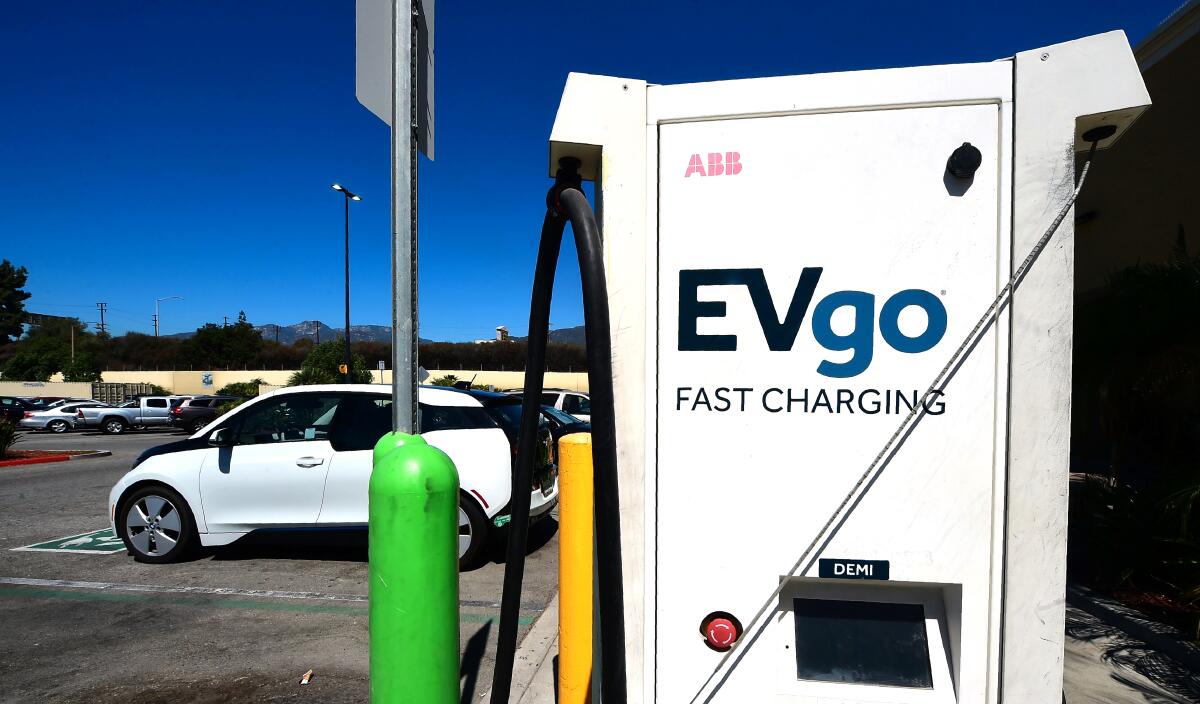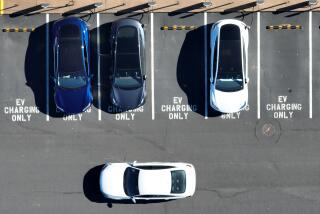Op-Ed: What it will take to get electric cars into low-income communities?

The California Energy Commission said in June that the state needs about 1.2 million electric vehicle chargers in public and shared private locations, such as office complexes and multi-unit dwellings, to meet its mandated goal of putting 8 million zero-emission passenger vehicles on the road by 2030.
With just 73,000 or so public and shared chargers available today, that means the number of chargers statewide would need to increase by about a factor of 15. An expansion of that magnitude in a period of nine years cannot be achieved if current patterns persist in terms of who buys electric vehicles and where charging stations are built.
To accelerate EV adoption and meet the state’s goals, electrification must happen more equitably and profitably. Currently, most electric fast-charging stations in Los Angeles are located in neighborhoods where residents can afford electric vehicles; by contrast, areas where average incomes are below $50,000 are often “charging deserts.”
The problem is that the public charging network for electric vehicles has been designed to serve early adopters — the drivers who can afford the higher upfront cost of an electric vehicle. But if developers of charging stations wait for more charging demand to emerge organically, lower-income communities will continue to be left out and the state’s goals for vehicle electrification will remain out of reach.
Fortunately, economic and policy factors are beginning to align in ways that could catalyze the development of a much larger EV charging network that works for everyone.
First, electric vehicles are becoming increasingly affordable, driven in part by a rapid drop in battery costs. The upfront cost of some EVs may reach parity with their gasoline-powered alternatives as soon as next year, according to the latest research from BloombergNEF. Meanwhile, the first generation of long-range, lower-cost EVs such as the Chevrolet Bolt and Tesla Model 3 are starting to change hands as they come off lease or the original owner sells.
These cars create a market for used EVs that has been almost nonexistent to this point. As new and used EVs become more affordable, a wider swath of drivers will be able to buy them, generating demand for public charging in the areas where they live and work.
Second, under the new California Clean Miles Standard, rideshare companies such as Uber and Lyft must begin electrifying their California fleets in 2023. And by the end of the decade, 90% of ridesharing miles in the state must be electric. The Clean Miles Standard adds regulatory pressure to the companies’ own pledges for electrification.
A recent analysis from RMI of 101 million rideshare miles showed that rideshare drivers of electric vehicles currently have to leave their neighborhoods and operate in wealthier neighborhoods where the public charging stations exist. And according to Lyft’s statistics, 46% of Lyft rides start or end in low-income areas, which means there’s plenty of demand for ridesharing inside these communities to support an electric fleet if public charging stations exist.
The Clean Miles Standard necessitates investment in charging infrastructure everywhere, but especially in lower-income communities that are underserved by the existing charging network. This would also spread the benefit of reducing local air pollution by replacing internal combustion engines.
Electrifying vehicle fleets is crucial in part because each vehicle sees much more use than a personal vehicle does. A 2020 study by Alan Jenn of UC Davis found that electrifying a single Uber or Lyft vehicle yields the environmental and emissions benefits of electrifying about three private vehicles.
By electrifying en masse, a vehicle fleet can also change the economics of charging on a large scale. RMI’s analysis found that the charging network in L.A. will have to grow by a factor of three to six just to support electrified ridesharing fleets.
With ridesharing drivers as anchor customers, we found that a robust, widespread charging network can quickly reach profitability for station operators. In our analysis, we focused on direct-current fast chargers — the stations where drivers can recharge on the go — which are especially important for fleets that need to minimize vehicle down-time. They also benefit lower-income drivers generally, who may not have access to private charging at home or work. But despite the promising economics, the build-out of fast charging is still challenging, with frequent permitting delays, complex regulatory processes and other costs.
These barriers will need to be eliminated for California to reach its electric-vehicle, climate and air quality targets. Policymakers can direct public funds to provide better access to charging in low-income neighborhoods and a more inclusive transportation system overall. And utilities must ensure that their rate structures do not discourage the development of new EV charging stations. For instance, fees based on peak power usage can be prohibitively expensive for fast-charging stations.
Alternative solutions include a short-term “holiday” from these charges, or a sliding-scale approach that phases them in to allow stations to build up a steady base of utilization and revenue.
If California can spur the growth of a broad and equitable charging network, it will provide a model for the rest of the country by building a cleaner, more sustainable future for transportation.
Britta Gross is the managing director of the Carbon Free Mobility Program at RMI, a nonprofit research organization focusing on clean energy.
More to Read
A cure for the common opinion
Get thought-provoking perspectives with our weekly newsletter.
You may occasionally receive promotional content from the Los Angeles Times.










